
Following on from this week's reveal of the upcoming Ruined Castle Wall section, today we have another damaged terrain piece to announce - the Ruined Stone Wall!
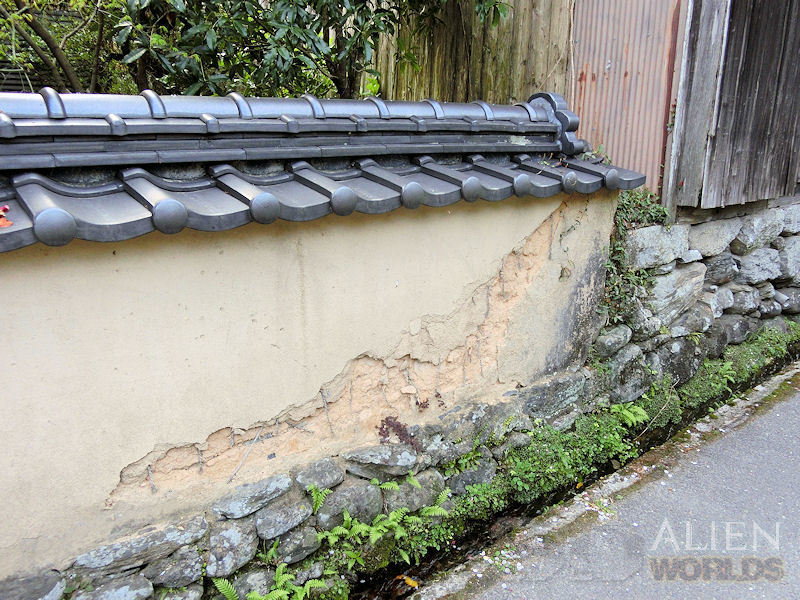
£ This was the inspiration for the ruined wall section, which I photographed a while back on one of my little wanderings through old Japanese villages. The construction is quite interesting - a rough frame of bamboo is held together with twine (you can see this poking out of the damaged parts), and then the wall's core is built up with rocks and dried mud. Finally, the outer facing is plastered on, and this is the part that tends to fall off first, due to age, bumps or earthquakes.
So the goal was to incorporate some of those details into this new ruined section, to give your tables some extra realism. Here's how it looks....

£ This ruined section comes in 4 parts, and simply replaces an undamaged 120mm section of stone wall from the existing set.

£ If you look closely you should be able to make out the bamboo and twine frame inside the damaged wall, and there are also some tiles from the roof scattered in the broken rocks and rubble at the base.
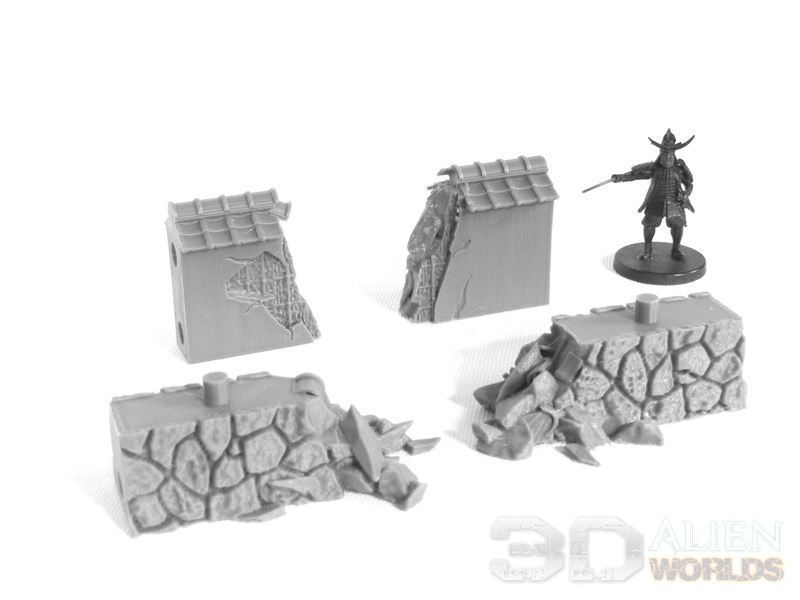
£ Here's a look at how the 4 parts separate. The upper walls have holes for magnets in the ends, and also holes in the bottom to fit onto the stone bases.
They can all be printed without supports, and I printed these at 0.1mm layers since they are pretty small and fast to make.
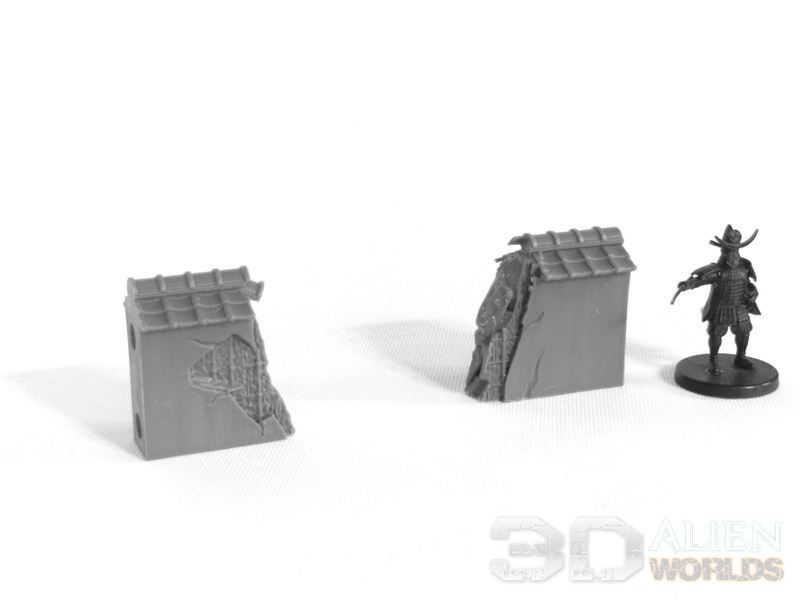
£ If you want, you can also use the upper walls without the stone bases, for lower height walls.
These ruined stone walls are currently on the paint desk along with the ruined castle walls, and will be released very shortly. Watch this space!
There was such a great response to the Temple Walls set released at the weekend, that I wanted to push on quickly to bring out 2 little additions to the samurai collection.
The first of these new releases will be a ruined castle wall section, to fit into the existing castle wall pieces.
£ Here's a photo of the real-life inspiration for the ruined section - the famous Kumamoto castle, after its walls collapsed during the big 2016 earthquake.

£ Our castle walls are slightly smaller in scale, but this ruined section can slot neatly into a double-width section in your castle wall layout. You could either model it as a quake-collapsed section, or possibly a breach in the walls caused by battle damage or an explosion!

£ You can also choose to model it without the top wall pieces, if you prefer.

£ The collapsed section has been modelled with playability in mind, with a slightly flattened bottom and some handy 25mm-base-sized rocks at variousl points, rather than a solid slope all the way up.

£ Here's a close-up of the wall tops. They feature the arrow slits from the undamaged walls, with cracks, broken tiles and missing plaster sections on the outside, plus glimpses of the bamboo pieces used to hold the walls together. A whole lot of authentic details there!
The first set from our Japanese samurai-themed grand temple project is being officially released today, so the Samurai Temple Walls are now available for download!
Plenty of lovely pics to show you today, and even a short video!
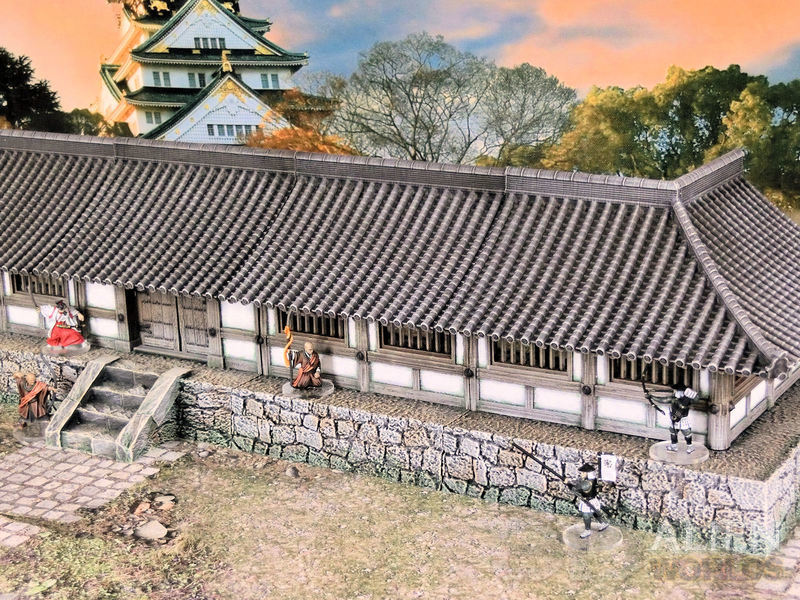
£ The set consists of 3 parts - straight sections, doorway sections, and a corner section. All of these come with stone bases too, so you can customise your layout in lots of ways!

£ The doorway section features narrow steps on the outside, leading up to the heavy wooden door, and then wide steps down again on the other side.
He we see one of the temple priests turning away a passing beggar, at the pointed end of a naginata!

£ The inside of the temple walls feature this paved walkway covered by the wide curved roof, and these wide stone steps.

£ You don't even need to glue the roof sections in place, providing even more options for gameplay!
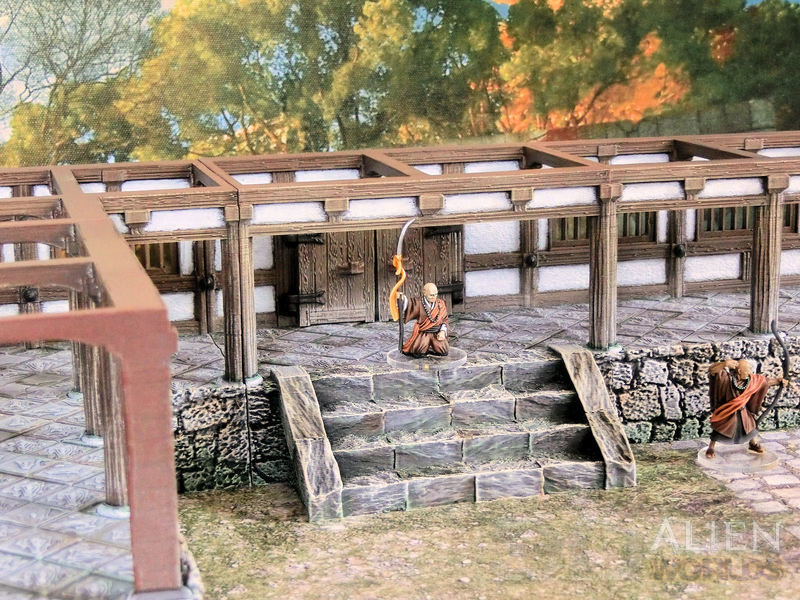
£ The heavy wooden door can be barred and closed, or opened during play.
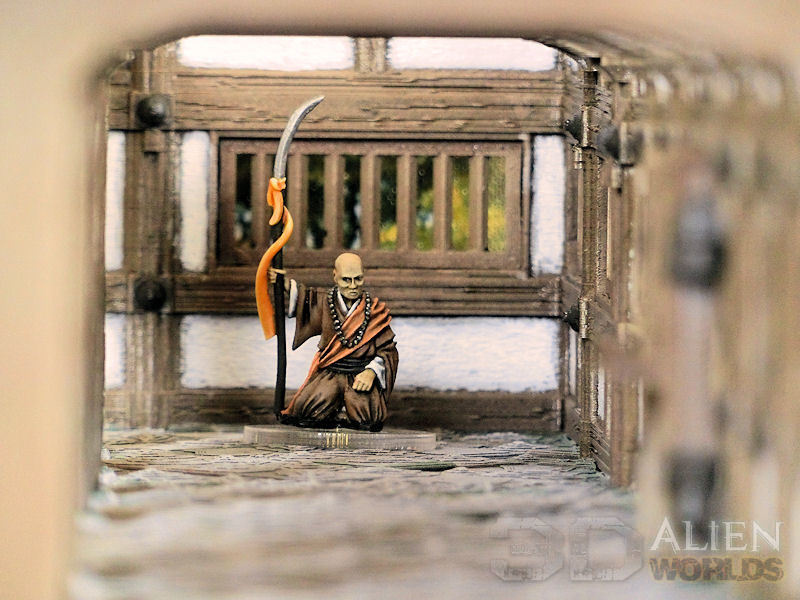
£ This set also makes a pretty good background for photographing your models!
Here we can see one of the priests kneeling at the end of one of the walkways, readying himself for the coming fight!
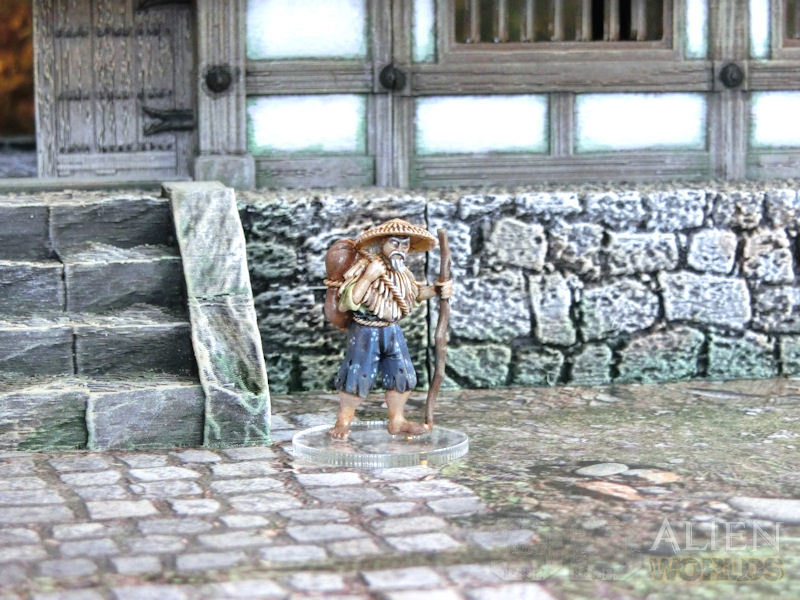
£ This penniless beggar is another great model from the "Unlikely Allies" set by Grey for Now Games, and makes a colourful addition to a gameboard. Here he is, trudging around outside the temple walls.
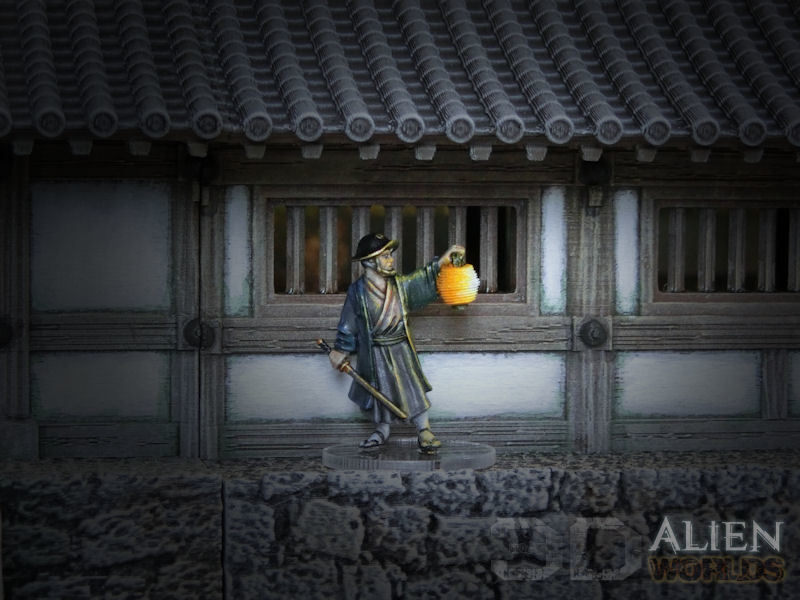
£ This final pic is the watchman from the same "Unlikely Allies" set, with a dark edged filter placed over the photo. It really sets the scene for those ninja-based night missions!
We also have a short video for you, to set the scene for a clash between temple priests and some marauding samurai forces....
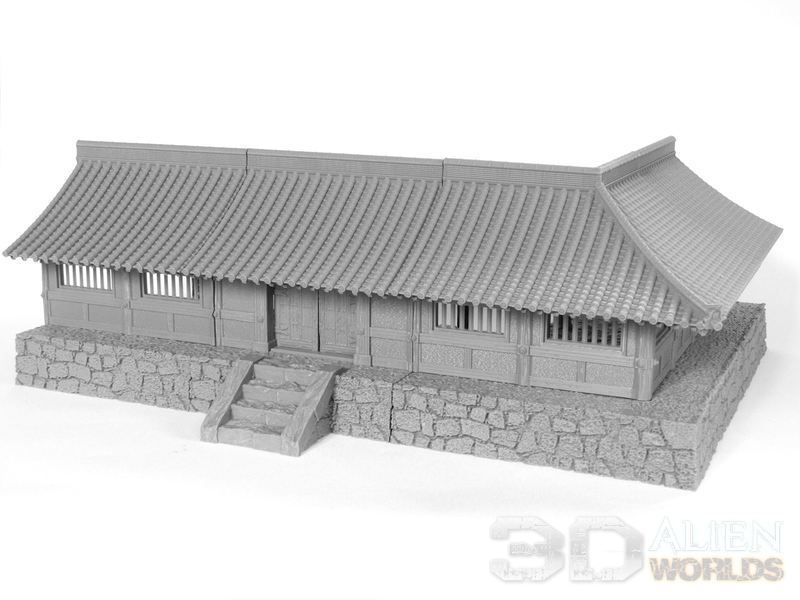
The Samurai Temple Walls are available for download from today!
The first decision you have to make is what colour you want to paint your temple walls! You've basically got two choices - brown or red?
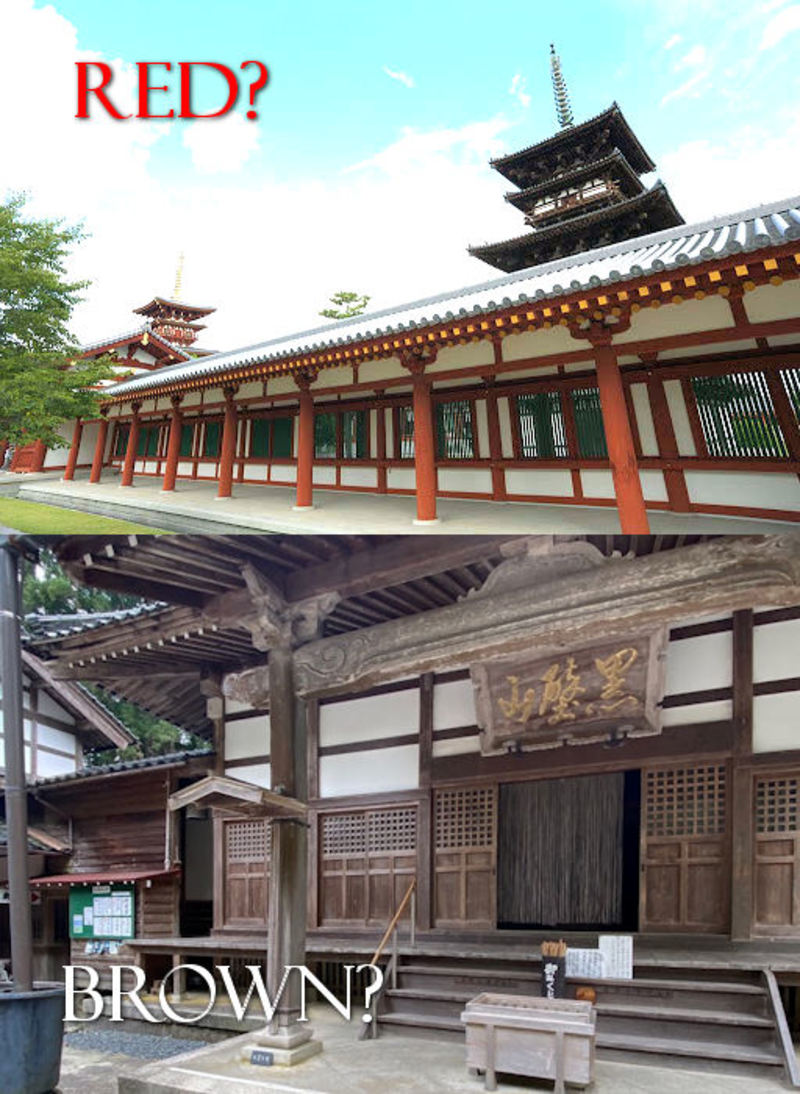
£ Red-painted temple walls (and buildings) are rarer in Japan, although they do exist. Shinto shrines are more usually painted in red, and you can use these temple walls as shrine walls if you want, but Buddhist temples are more usually just left as natural unpainted wood.
So I recommend you do a quick image search to find the colour scheme you like. I asked everybody on Facebook which scheme they preferred, and unfortunately the votes came back pretty much tied! So no help there.
Red temples are perhaps more often found in city settings, where the money is available for grander buildings and regular repainting. But after some thought, I decided to paint mine in old wood colours.... mostly because I enjoy adding aging and weathering to models.
So with that decision out of the way, it's on to the painting guide...
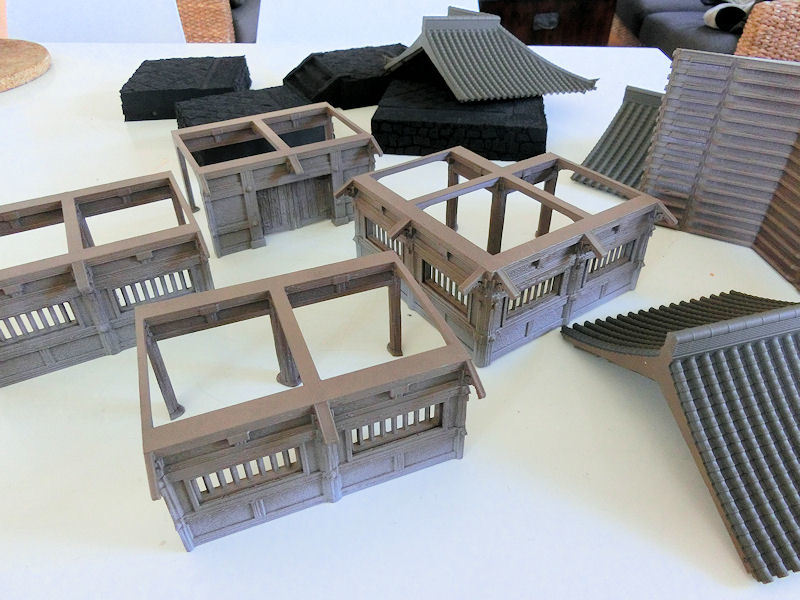
£ Whenever possible I like to speed things along with rattle-can spray undercoats doing double-duty as base colours. So the wall bases were sprayed with matt black, the walls and roof undersides were sprayed in matt brown, and then the roof topsides were sprayed in a dark matt grey.
As a last touch for basecoating, I also sprayed a gentle mist of light grey on the bottom 2cm or so of the outside of the walls. This will work later as water damage and weathering.
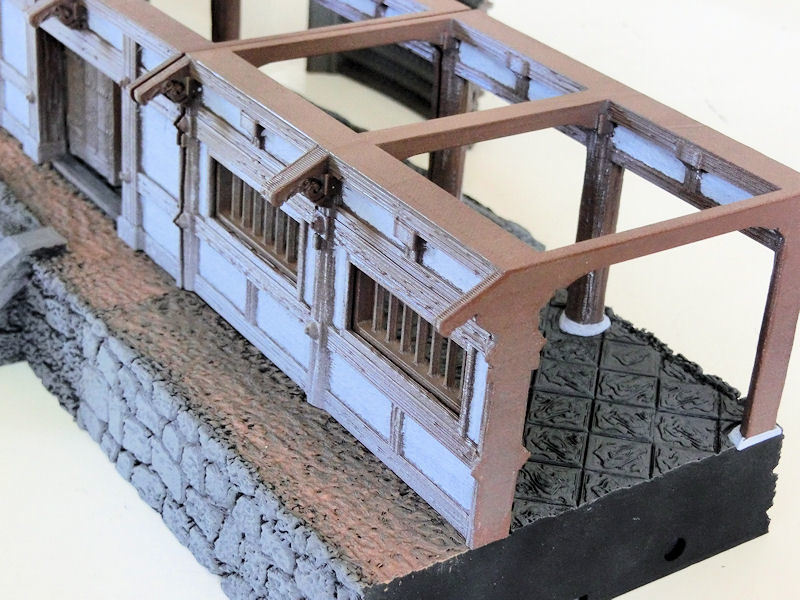
£ There were a few more things that needed basecoats, so I roughly painted the stonework with a medium grey (Neutral Grey by DecoArt), and the dirt path with a brown (Sable Brown by DecoArt).
The most time consuming step was to then paint the wall panels in a light grey with a flat-edged 1cm-wide brush. These would later be finished in white, but I wanted to do the hardest part now, before washes were added - so the edges would blend a little better with a wash on top.
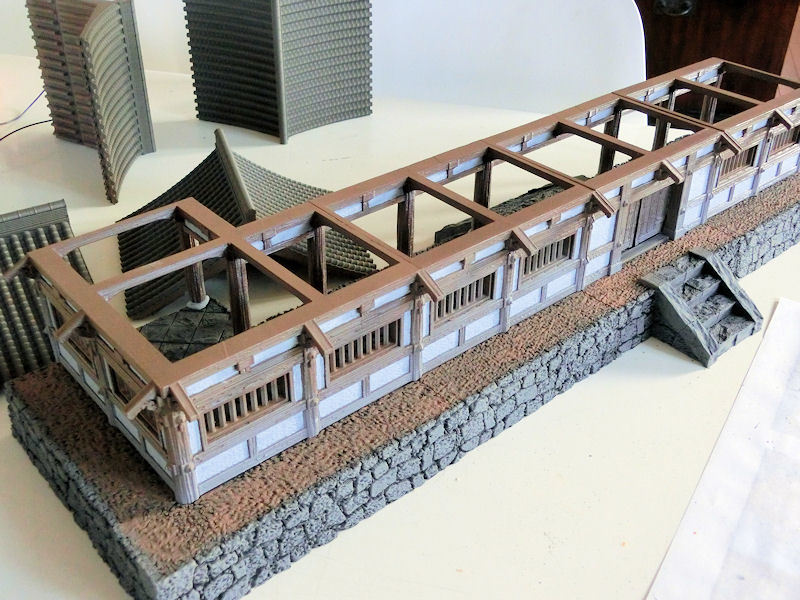
£ Here we are at the halfway stage. The base colours are done, so it's time to see how it looks all lined up!
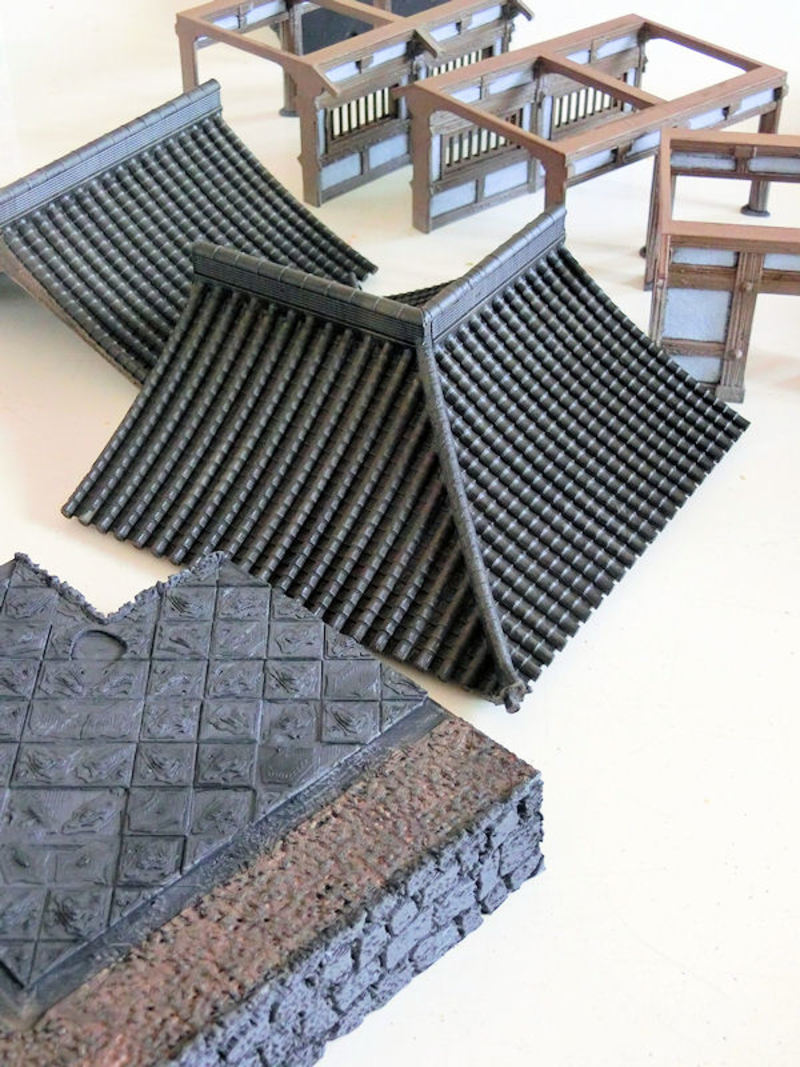
£ Time for washes! The base sections and roof sections all got a heavy black wash to darken things down and add shadows.
The wooden sections got a brown wash just to add some shadows and lines to the wooden areas. I tried to avoid adding wash to the light grey wall panels, but it's not too hard to wipe away smudges.
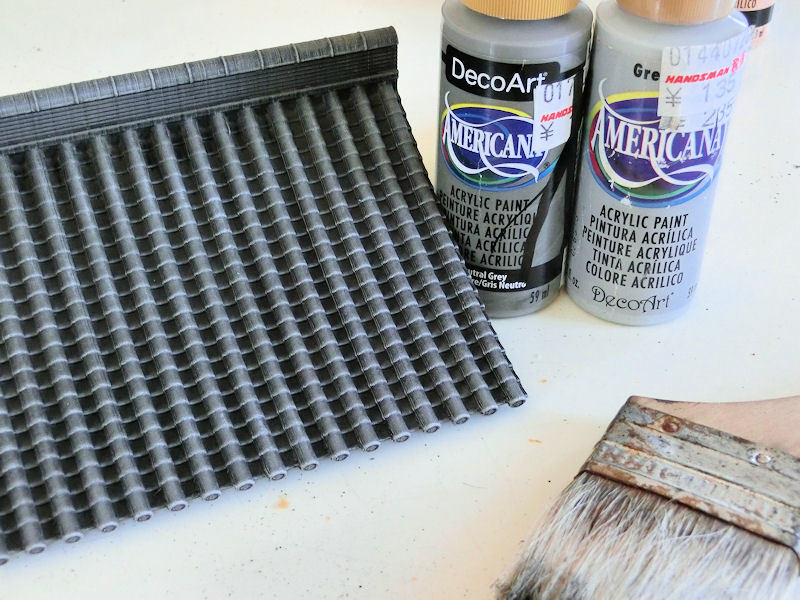
£ Next comes the drybushing, which I did with a 2" wide paintbrush. I first drybrushed the roof sections in a medium grey, and then again very lightly with a light grey. For the light grey drybrush, I recommend gently dragging the brush UP the rooftiles, so it will catch the very edges.
The roof sections were finished!
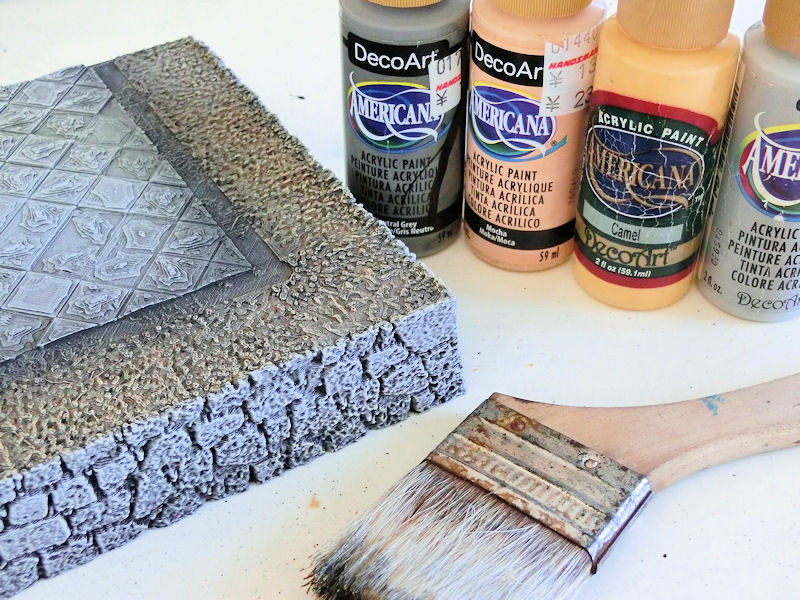
£ The base sections similarly received heavy drybrushing in medium grey and then light grey for the stonework, and also some skin and sand-coloured drybrushes on the dirt areas. I didn't worry too much about keeping it neat, as rocks and dirt tend to blend together anyway in real life.
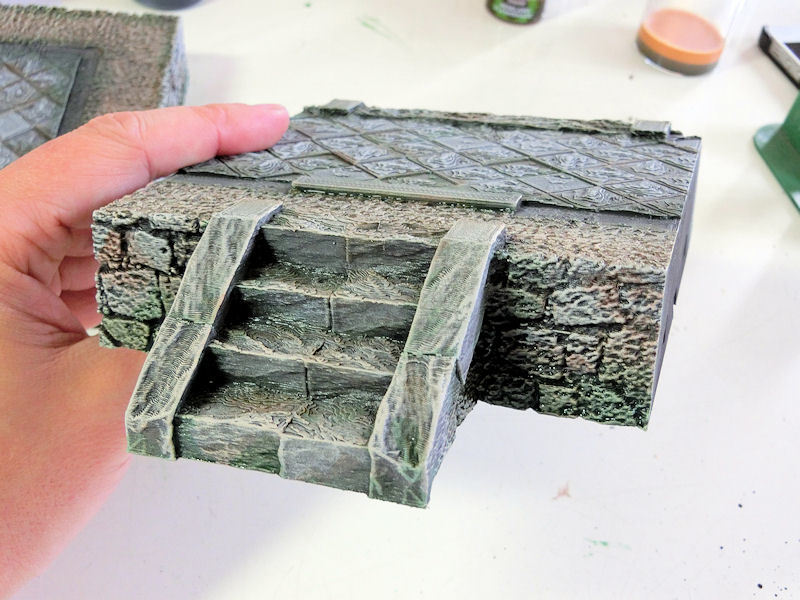
£ With the drybrushing complete, you'll probably find that the stones are too uniform and neat. I started adding washes in various colours to some stones - brown wash on some, red-brown wash on others. You can see some of them on this close-up pics above and below.
One other wash colour I strongly recommend is green! Adding a few millimetres of green wash all along the bottom edge of each section, and pushing it heavily into nooks and crevices, gives a great sense of age. You'll often see this on Japanese stonework, where the sun doesn't burn hot enough to remove the mold. The green on the bottom edge also helps to blend the base sections into a tabletop mat, I find.
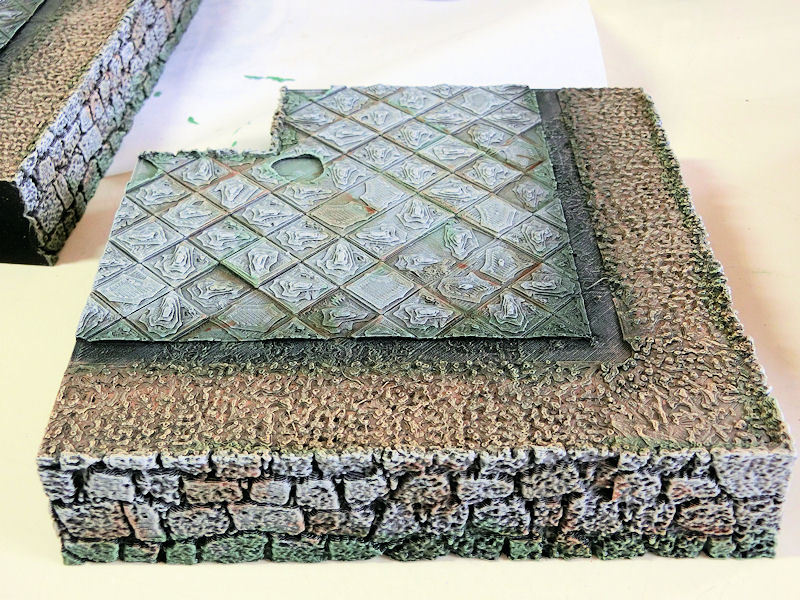
£ The paving stones on the top of each base section also got washes pushed at random into crevices and cracks, just to make it more interesting and less uniform.
The base sections were now complete - just the wall sections to go!
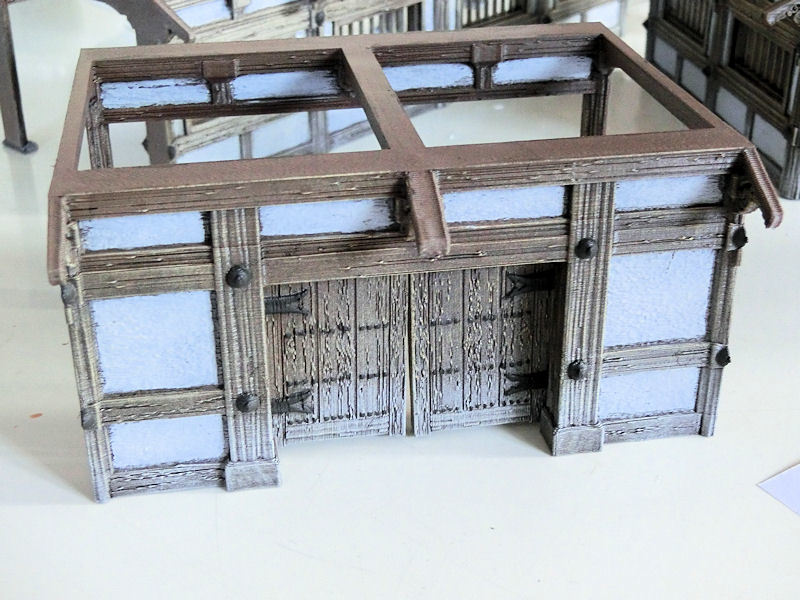
£ Using a 1cm-wide brush, I carefully drybrushed the wooden edges very lightly with a sand colour (Camel by DecoArt), just to bring out the woodgrain, and then switched to a light grey drybrush for the bottom 2cm of each wall section. You don't need to do this on the inside of the walls, but on the outside walls (and doors) it looks great - it's where rain and sun will fade the bottom pieces of wood naturally.
There are metal studs every metre or so along the walls (and the door hinges), and I painted mine in dark grey (Charadon Granite by GW) then gave them a black wash to add some depth.
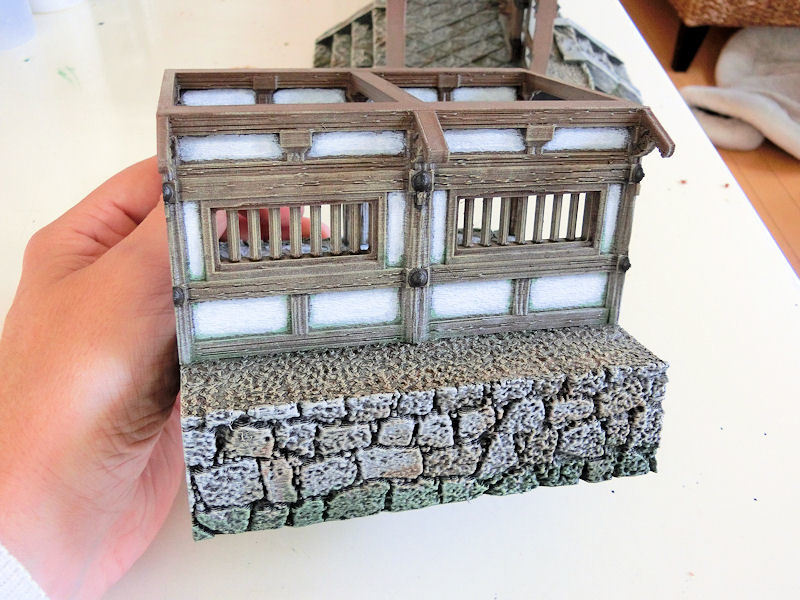
£ Using a firm rounded brush, I then carefully stippled on white to the centre of each wall panel, and pushed it out from there to blend it with the light grey at the edges. One more pass with white stippled on the very centre of each panel, and the walls were ready for their final weathering.
I jabbed some green wash into the bottom corners of the lower wall panels, and the recesses of the thick upright timbers.
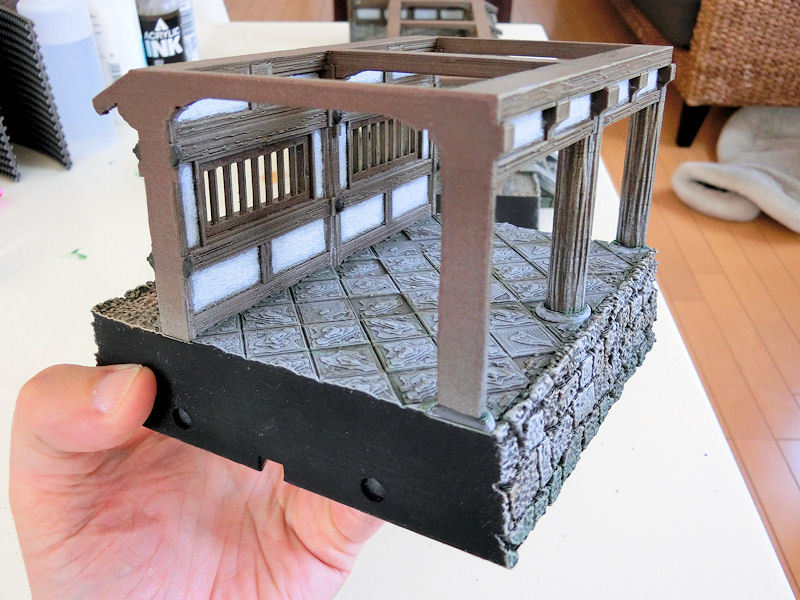
£ All done! With the painting completed, I was finally able to glue the walls to their base sections - although you could leave them separate to give you more gaming opportunities?
Some truly epic photos to show you today, from Thomas (Lascaris on various forums) who has just finished his massive Japanese display board. He used 11kg of filament and over a thousand hours of print time to produce this huge castle layout, which he then shipped off to his brother to have painted! His poor brother....... 😂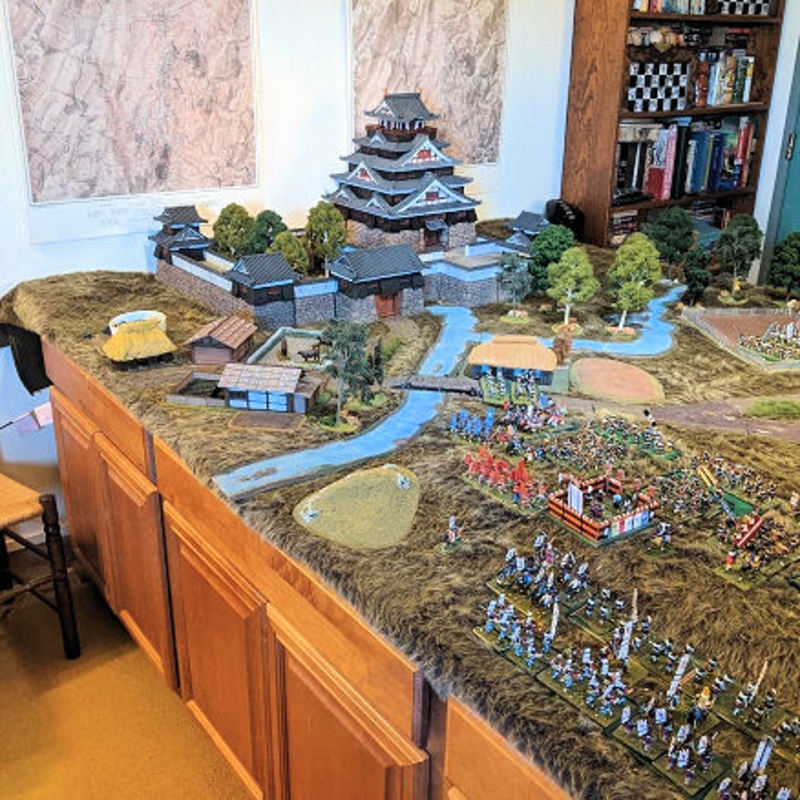
£ Just. WOW.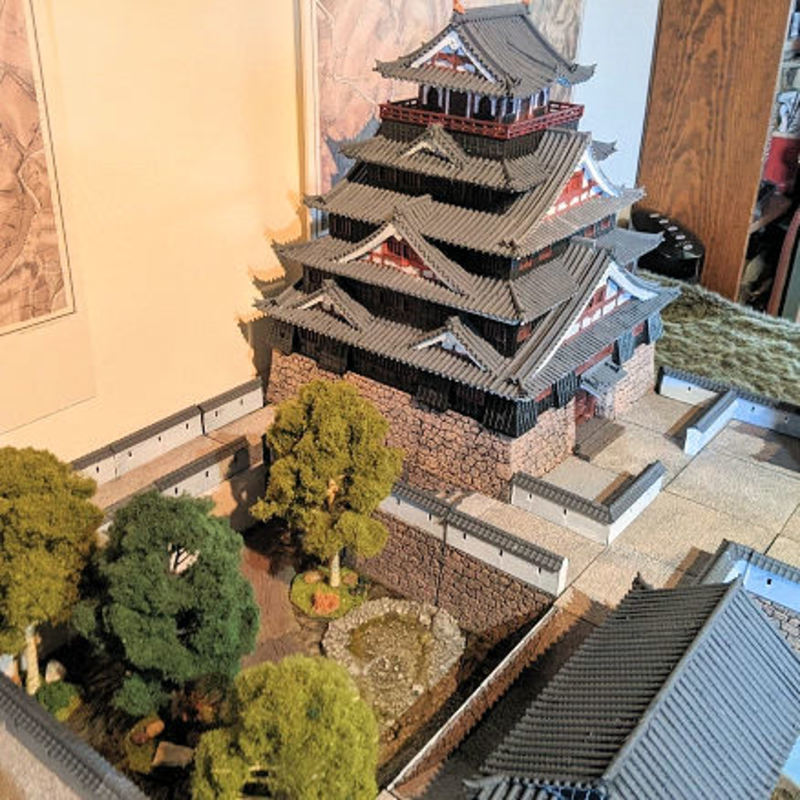
£ He's obviously put a lot of thought into the layout of those castle grounds, with 3 corner towers, a castle gatetower and a large central garden on a lower level.
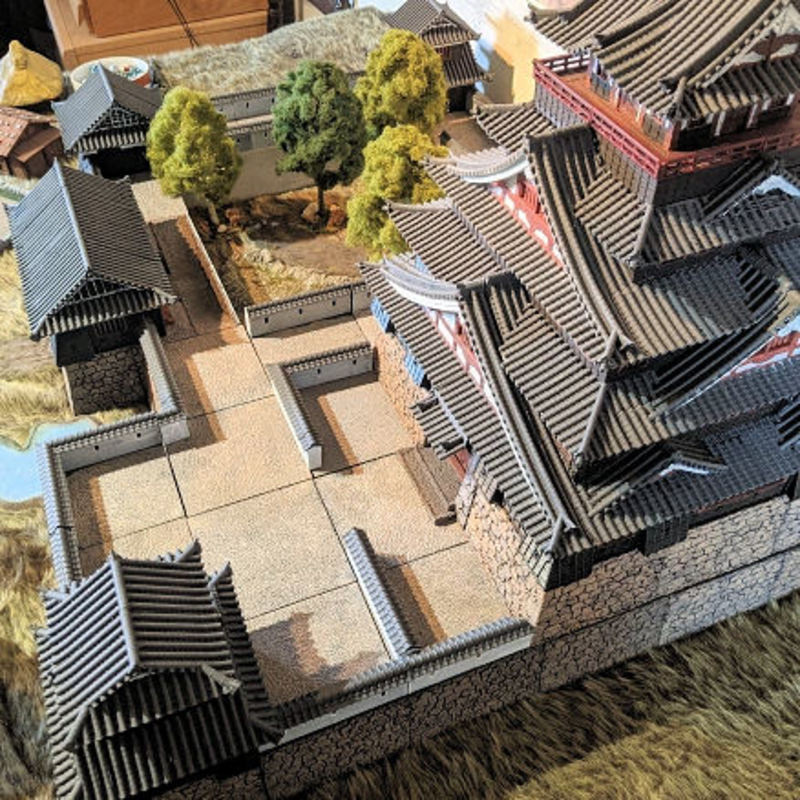
£ Great colour scheme for the castle too, with a striking red chosen for the timber beams.
Absolutely awesome work, Thomas!
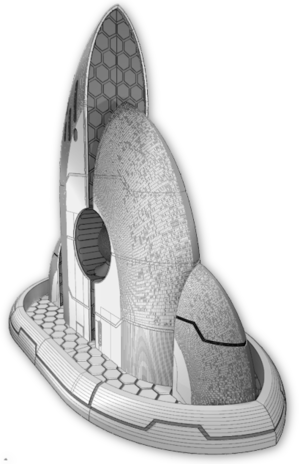
1 Comment :
Vaughan
2021-04-04 (Sun) 8:22AM
Excellent! Keep those awesome additions to the Samurai Line coming!
Write a comment :